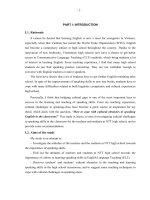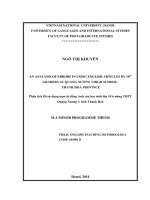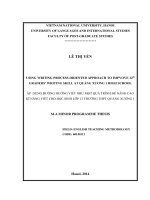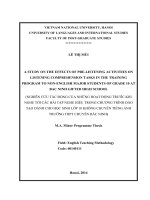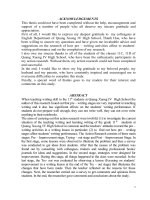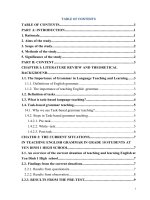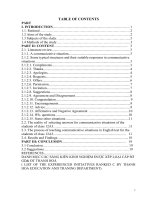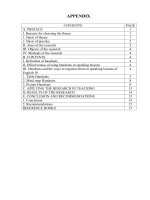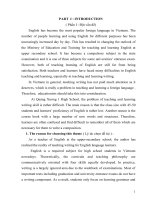Some experiences to teach vocabulary of reading lessons in textbook of grade 11 at quang xuong 1 high school
Bạn đang xem bản rút gọn của tài liệu. Xem và tải ngay bản đầy đủ của tài liệu tại đây (685.32 KB, 21 trang )
EDUCATION AND TRAINING DEPARTMEENT
OF THANH HOA PROVINCE
QUANG XUONG I HIGH SCHOOL
EXPERIENCE INITIATIVE
SOME EXPERIENCES TO TEACH VOCABULARY
OF READING LESSONS IN TEXT BOOK OF GRADE 11
AT QUẢNG XƯƠNG 1 HIGH SCHOOL.
( MỘT SỐ KINH NGHIỆM DẠY TỪ VỰNG
Ở BÀI ĐỌC TRONG CHƯƠNG TRÌNH TIẾNG ANH 11
TẠI TRƯỜNG THPT QUẢNG XƯƠNG I)
Written by : Nguyễn Thị Thanh Ngọc
SCHOOL YEAR : 2017 – 2018
1
TABLE OF CONTENTS
Page
PART I : INTRODUCTION
1.1.Reasons for choosing the topic………………………………………. 1
1.2 Aim of the study……….…………………………………………… 1
1.3. Scope of the study ……………………………………………………2
1.4.Method of the study …………………………………………………..2
PART II: DEVELOPMENT
1. Theoretical background ……………………..……………………….. ..3
2.The actual situation………………………..…………………………… 3
3. Patterns of the study………….………………………………………… 4
3.1.Preparation ………………………………………………………….. 4
3.2.Vocabulary teaching method…………………………………………. 4
3.3. Vocabulary teaching techniques ……………………………………. 4
3.4. Procedures of teaching vocabulary in a reading lesson…………… 5
3.4.1. Pre-reading ………………………………………………………. 5
3.4.2.While – reading ………………………………………………….. 7
3.4.3. Post – reading ……………………………………………………. 14
4. Effectiveness of experience initiatives for educational activities. …… 15
4.1.Effectiveness of experience initiatives……………………………… 15
4.2. Compared to the amount of the initial survey …………………….. 15
4.3.The effectiveness of the measures used ………………………….. …16
PART III: CONCLUSION AND RECOMMENDATIONS
1 Conclusions ……………………………………………………….… 16
2. Recommendations. …………………………………………………
16
2
PART I: INTRODUCTION
1.Reasons for choosing the topic
English as an international language has been used for all over the world in recent
years. English plays an important role in people’s communication. English is an
compulsory subject in national exams.
Changing teaching methods in education is the right action of teachers and
students in teaching and learning process. The change is always understood by
carrying out some specific forms. The method of teaching is the forms and
performances of teachers and students in the teaching conditions in order to achieve
the purpose of teaching .
Vocabulary is one of five core components of reading instruction that are
essential to successfully teach students how to read. These core components include
phonemic awareness, phonics and word study, fluency, vocabulary, and
comprehension. Vocabulary knowledge is important because it encompasses all the
words we must know to access our background knowledge, express our ideas and
communicate effectively, and learn about new concepts. Students’ word knowledge is
linked strongly to academic success because students who have large vocabularies can
understand new ideas and concepts more quickly than students with limited
vocabularies. The more words you know, the more you will be able to understand
what you hear and read; and the better you will be able to say what you want to when
speaking or writing.
However, students have some difficulties in understanding a common reading
because of vocabularies. Reading texts often contain many new words while their
vocabulary is low. When encountering new words, they often stop to look up a dictionary.
This habit takes a lot of time to complete a reading and makes students passive in
vocabulary learning, reading comprehension, vocabulary memorization and practicing
them.
To help students improve their vocabulary knowledge, in teaching process in
English grade 11 in high school, I would like to express some ways
to teach
vocabulary effectively so that students can overcome difficulties in vocabulary.
2. Aim of the study
In the experience of this initiative, I just want to make some ways in showing
meaning of new vocabularies in a reading lesson in order to improve the quality of the
lessons, help students easily understand themes and memorize new words more easily
3
and using them effectively. Teachers can use my research to help students more
interested in learning English
3. Scope of the study
As we know, the vocabulary of English at Upper-Secondary School students today
have to learn a lot of vocabulary so I want to focus on this topic to explore appropriate
methods to help students better understand.
I conducted my research in the teaching vocabulary of English at the 11th
Grade of Quang Xuong I Upper-Secondary School in the academic year 2017-2018
with the basic textbook of the Ministry of Education and Training . Participating
classes are11T1, 11C4, 11C5
4. Method of the study
To fulfill this study, a mixed use of both quantitative and qualitative methods are
applied. The data are collected by means of tests.
4
PART II: DEVELOPMENT
1. Theoretical background
One of the oldest findings in educational research is the strong relationship
between vocabulary knowledge and reading comprehension. Word knowledge is
crucial to reading comprehension and determines how well students will be able to
comprehend the texts they read in high school. Comprehension is far more than
recognizing words and remembering their meanings. However, if a student does not
know the meanings of a sufficient proportion of the words in the text, comprehension
is impossible. Knowing at least 90 percent of the words enables the reader to get the
main idea from the reading and guess correctly what many of the unfamiliar words
mean, which will help them learn new words. Readers who do not recognize at least
90 percent of the words will not only have difficulty comprehending the text, but they
will miss out on the opportunity to learn new words.
Studies have shown that the key to increase vocabulary is exposure the new
words. Vocabulary development is an attainment goal. If given the opportunity to
learn new words as well as effective teaching method, most students can improve
their vocabulary knowledge and their comprehension.
2. The actual situations
Quang Xuong 1 high school is a school in rural of Quang Xuong. English is a
compulsory subject in the national high school examinations. However, some of
students still do not really care about the subject for some reasons. They only focus on
their exam subjects. English is a very special subject, making it difficult for them if
they do not really concentrate and practice it regularly. Besides, they are rural
students, the conditions for practicing English are not so great. So the academic
achievement of this subject is not high and there are still weak students.
Result before the research in teaching
The first term of school year: 2017-2018
Class
Number of Excellent- Rather
Average
Weak
students
good (%)
(%)
(%)
(bad)
(%)
11T1
47
≈6
38
53
3
11C4
38
4
25
66
5
11C5
38
>3
14
74
9
5
Before investigating, proportion of weak students are high accounts for 3 to 9 percent
and they are not interested in learning English especially learning vocabulary.
3. Pattern of the study
3.1.Preparation
Before starting a new lesson, both the teacher and students have
good preparation. When teaching reading comprehension, the teacher should tell
the students the ways to learn new words, find the family words or build sentences
with some words having in the lesson. Depending on the levels of each class and
students, the teacher has different requests. This makes students more responsible for
the lesson, feel confidence, understand and apply it more effectively, and they think
that studying English becomes more and more interesting.
3.2. Vocabulary teaching methods
Normally, a reading text always appears some new words, but it is not
necessary to teach all of them and teach them in the same ways. The teacher should
choose words which need teaching and method to teach them effectively. Choosing
words to teach, the teacher has to classify into two forms of vocabulary. They are
active and passive vocabulary.
• Active words are words which students know and use in communicating or
writing.
• Passive words are word which students only know and understand when they
read a text.
The ways to teach two forms of these words are not the same. Active words
relate to 4 basic skills: Listening, Speaking, Reading and Writing. The teacher,
therefore, needs to spend more time presenting and practicing, specially the ways to
use the words. To passive ones, however, students can only know and students don’t
need to spend much time using them.
If the new words are very important to understand the content of the passage
and suitable for the level of students, the teacher should explain vocabulary actively.
If the words are not important but they make the students get
difficulties, the students should be taught passively- the teacher explain the new
words or translate them quickly. The teacher asks the students to guess the meaning of
new words if the words are important and easy in the passage. And the teacher can
ignore if the words are difficult and strange and they are not related to the passage.
3.3. Vocabulary teaching techniques
If the teacher only writes and explains vocabulary following dictionary, most
6
students cannot understand the ways to use the words in communicating
and specially with active words. Besides, students have to know not only the way to
pronounce words, but also the way to pronounce phrases. Moreover, students know
the meaning of new words and how to use them.
a. Teaching pronunciation :
When students can pronounce new words well, they will write the words
correctly. So the teacher should teach the students the best ways to read the words
exactly.
b. Guessing meaning from the context:
Context is sentences which explain or definite new words. Therefore,
when students want to know new words, they should read the whole context. This can
help students to know more about vocabulary or their part of speech such as nouns,
verbs, adjectives, adverbs… In addition, context also helps students to realize some
suggestions about the meaning of new words without stopping reading to look up the
dictionary, which makes students read more quickly and better.
c. Show the meaning of new words:
There are some basic ways to explain the meaning of new words:
-Using real objects.
- Using prefixes/ suffixes, root words.
- Using definition forms, synonyms or antonyms, part of speech.
3.4. Procedures of teaching vocabulary in a reading lesson.
3.4.1. Pre-reading
There are many ways used in this activity. The teacher can choose each suitable
way for each lesson.
a. Open Prediction :
The teacher show the topic and asks students to guess what the content of reading is.
Τ Example: Unit 6: Competitions
- The teacher asks some students to put questions to other students by using yes/no
questions to guess the meaning of vocabulary:
+ Is the word a verb?
+ Is it a noun?
+ Does it begin with “c”?
+ To work with weak students, the teacher should give some more suggestions:
Does it have 11 letters? or Is it about an animal/ a plant…?
- The students take turns to put questions and the student who gives the correct
7
answer with the shortest time will be the winner.
a. Jump words
Dividing class into 3 or 4 groups, the teacher delivers hand-outs and asks students to
arrange letters into the meaningful words in the reading leson.
For example in unit 7 of grade 11 about Population, teacher introduce the situation of
the reading passage and give some jumped words.
1. tbhir
2. etahd
3. chidlrne
4. fliamy plnangni
Key
1. birth
2. death
3. children
4. family planning
c. Ordering:
The teacher shows some pictures and asks students to arrange them in correct order.
For example: The teacher introduce the situation of the reading passage and asks all
students to look at the pictures in the unit 2 then arrange them in correct order.
Key : 1.d, 2.b, 3.f, 4.e, 5.a, 6.c
8
3.4.2. While reading
Generally, a reading lesson usually has some new words, and all of them cannot
be explained in the same way. The teacher needs to select and decides which words
are active and others are passive.
a. Using real objects:
The teacher can use real objects in class or take some pictures, diagrams…to
classroom or draw some pictures on the board. Besides, the teacher can use body
languages
For example: To teach some new words in reading lesson of unit 15, teacher can use
picture , gesture to show the meaning.
- Gestures: swimming, driving a car, accompanying
- Pictures:
Orbit (n)
Weightlessness (n)
Cosmonaut (n) = astronaut (n): Nhà du hành vũ trụ
9
The teacher can show the pictures or real things to teach new words, which
helps students understand and interest in learning vocabulary. By this way, students
can remember vocabulary for a long time and feel more attracted to study it.
b. Using prefixes/ suffixes, root words:
One method of understanding the meanings of new words is to analyze the
different parts of the word and the meanings of those parts. Many new words are
formed by adding an affix to the beginning or end of a Latin or Greek root or root
word. When affixes are added to the beginning of roots or root words, they are
called prefixes For example, the most common prefix is un-, which meant not or
opposite of. If you add un- to the word happy, the new word becomes unhappy, which
means not happy. When affixes are added to the end of roots or root words, they are
called suffixes. The most common suffixes are -s and -es, which mean more than one
(or the plural) of the word. Adding -es to wish, changes the meaning o the word to
more than one wish. So this is considered a good and easy way to teach vocabulary.
The teacher can use prefixes or suffixes to show the meaning of new words.
Common Prefixes
Prefix
antidedisen-, emforein-, imin-, im-, il-, irintermidmisnonoverpreresemisubsupertransun-
Definition
against
opposite
not; opposite of
cause to
before; front of
in
not
between; among
middle
wrongly
not
over; too much
before
again
half; partly; not fully
under
above; beyond
across
not; opposite of
Examples
anticlimax
devalue
discover
enact, empower
foreshadow, forearm
income, impulse
indirect, immoral, illiterate, irreverent
interrupt
midfield
misspell
nonviolent
overeat
preview
rewrite
semifinal
subway
superhuman
transmit
unusual
10
under•
under; too little
underestimate
The teacher can use suffixes to teach vocabulary
Common Suffixes
Suffix
Definition
Examples
-able, -ible
is; can be
affordable, sensible
-al, -ial
having characteristics of
universal, facial
the dog walked,
-ed
past tense verbs; adjectives
the walked dog
-en
made of
golden
-er, -or
one who; person connected with
teacher, professor
-er
more
taller
-est
the most
tallest
-ful
full of
helpful
-ic
having characteristics of
poetic
-ing
verb forms;present participles
sleeping
-ion, -tion,
submission, motion, relation,
act; process
-ation,-tion
edition
-ity, -ty
state of
activity, society
-ive,
-ative,
active,
comparative,
adjective form of noun
-itive
sensitive
-less
without
hopeless
-ly
how something is
lovely
-ment
state of being; act of
contentment
-ness
state of; condition of
openness
-ous,
-eous,
riotous,
courageous,
having qualities of
-ious
gracious
-s, -es
more than one
trains, trenches
-y
characterized by
gloomy
Furthermore, the teacher can use root words to teach vocabulary. Try to use
common roots with common words. This way must be repeated and repeated day by
day. The teacher ought to do it slowly and frequently. Some common roots:
Common root
root
ambi
Definition
both
Examples
ambiguous, ambidextrous
11
aqua
water
aquarium, aquamarine
aud
to hear
audience, audition
bene
good
benefactor, benevolent
cent
one hundred
century, percent
circum
around
circumference, circumstance
contra/counter
against
contradict, encounter
dict
to say
dictation, dictator
duc/duct
to lead
conduct, induce
fac
to do; to make
factory, manufacture
form
shape
conform, reform
fort
strength
fortitude, fortress
fract
to break
fracture, fraction
ject
throw
projection, rejection
jud
judge
judicial, prejudice
mal
bad
malevolent, malefactor
mater
mother
material, maternity
mit
to send
transmit, admit
mort
death
mortal, mortician
multi
many
multimedia, multiple
pater
father
paternal, paternity
port
to carry
portable, transportation
rupt
to break
bankrupt, disruption
scrib/scribe
to write
inscription, prescribe
sect/sec
to cut
bisect, section
sent
to feel; to send
consent, resent
spect
to look
inspection, spectator
struct
to build
destruction, restructure
b.Using definition forms, synonyms or antonyms, part of speech
The teacher can use both Vietnamese and English to show the meaning of new
words. The teacher can use definition forms, synonyms or antonyms.
Definition
For example : To teach vocabulary in Unit 6, teacher can use definition for explaining .
+ Representative : A person chosen or appointed on behalf of another person or group.
+ Annual : happening or done once very year.
+ Stimulate : encourage or make something more active.
+Spirit : enthusiasm and energy
+ In all : altogether or as a total
12
+ Smoothly : without difficulties or problem
Synonym: are words that have the same or a similar meaning. Synonyms can
provide students with variety in speech or writing, making it easy for you to avoid
overusing the same word and sounding repetitive. Some examples of synonyms
include the following:
Enormous = huge = gigantic = massive
Injured = damaged = wounded = harmed
• Intelligent, clever, brilliant, knowledgeable
• Look, glance, see, gaze, stare
• Loyal, faithful, ardent, devoted
• Old = elderly = aged = senior
• Organization = institution= management
• Partner = associate = colleague = companion
• Polite = courteous = gracious
• Quick = fast = swift = speedy = rapid
• Risky = dangerous
• astronaut = spaceman
• prohibit
=
ban
For example in unit 13 of grade 11 teacher ask students to choose the word that
has the closest meaning to the italicized word.
1. There are number of things I like to do in my free time.
A. leisure
B. precious
C. busy
D. idle
2. My uncle, who is an accomplished guitarist, taught me how to play.
A. unimpaired
B. skilled
C. ill-educated
D. unqualified
3. Now I can play a few simple tunes.
A. compound
B. plain
C. easy
D. complicated
4. I have a modest little glass fish tank where I keep a variety of small fish.
A. limited
B. excessive
C. conceited
D. moderate
5. The most important thing is to keep yourself occupied.
A. busy
B. relaxed
C. comfortable
D. free
Answer keys:
1.free (a) = leisure
2. accomplished = skilled (a)
3. simple(a) = easy (a)
•
•
13
4. Modest(a) = moderate (a)
5. occupied (a) = busy (a)
Antonym: are words that have contrasting meanings. Antonyms can be used to
help show contrast between two things or give clues to exactly what is meant.
Below are some examples of antonyms:
• appear # disappear
• independent # dependent
• Achieve # Fail
• Ancient # Modern
• Complex # Simple
• Compliment # Insult
• Decrease # Increase
• Demand # Supply
• Destroy # Create
• Powerful # Weak
• Praise # Criticism
• Problem # Solution
• Professional # Amateur
• Random # Specific
• Simple # Complicated
• Single # Married
• Strength # Weakness
• Tragic # Comic
• Wealth # Poverty
For example in unit 9 of grade 11 teacher ask students to choose the word that has
the opposite meaning to the italicized word.
1.Thanh Ba Post Office has a spacious and pleasant front office.
A.large
B. beautiful
c. cramped
D. open
2. Our well-trained staff are always courteous to customers.
A. helpful
B. rude
C. friendly
D. open
3. This speedy and secure service of transferring money can be useful.
A. rapid
B. hurried
C. careful
D. slow
4. If you want to send a document and do not want to lose its original shape, send
it by a fax machine.
14
A. unique
B. outdate
C. changed
D. imaginative
Answer keys:
1. spacious # cramped
2. courteous # rude
3. speedy # slow
4. original # changed
part of speech
A part of speech is a group of words that are used in a certain way. In the English
language many words are used in more than one way. This means that a word can
function as several different parts of speech.
For example, in reading lesson of unit 4, teacher ask students to complete the
sentences with different part of speech of word “volunteer”.
1.When she retired, she did a lot of …………………service for the Red Cross.
2.She was not fired. She left the company……………………
3.She needs some…………………….to clean up the kitchen.
4.Last month the company ………..to donate fifty trucks to help the flooded areas.
Answer keys:
1.voluntary (a)
2. voluntarily (adv)
3. volunteers (n)
4. volunteered (v)
In addition, the teacher can use other ways to help students guess the meaning of
vocabulary.
- When meeting new words, students must continue to read to understand other words
around new words.
3.4.3. Post reading
• Students will understand the meaning of vocabulary and know how to use them.
• Students can improve their ability to guess the meaning of new words and take
form the ability to read the text themselves.
• There are some exercises applied to practice studying vocabulary.
a) Matching: Students may be required to match opposites, synonyms, or a word
with its definition, as well as a picture to a word.
For example : In reading lesson of unit 13, teacher asks students to match word in
column A with words or phrases in column B to check students’ understanding and
practicing vocabulary .
A
B
15
1.Accomplished (adj)
2. Accompanying (gerund)
3. Modest (adj)
4. Avid (adj)
5. Discarded (adj)
6. Indulge in (v)
7. Keep me occupied
b.
c.
d.
e.
f.
g.
a. Keep me busy
b.Thrown away
c.Well-trained, skilled
d.Going with a singer, using a musical instrument
e.Let yourself do sth that you enjoy
f. Eager, crazy, enthusiastic
g.Not very large
Answer keys: 1.c, 2.d, 3.g, 4.f, 5.b, 6.e, 7.a
• accomplished (a) : Well-trained , skilled
• Accompanying (gerund) : Going with a singer, using a musical instrument
• Modest (adj) :Not very large
• Avid (adj) :Eager, crazy, enthusiastic
• Discarded (adj): Thrown away
• Indulge in (v) : Let yourself do sth that you enjoy
• Keep me occupied: Keep me busy
b) Blank filling
Another type of exercises using to check students’ understanding and practicing
vocabulary is filling each blank with a suitable word. Supply students with a piece of
written text with blank spaces that have to be filled in with any word that fits. You
may give them indications for each space, like “noun”, “adjective” or “adverb”, if
they’re advanced students. You can then read several out loud to compare the different
words used to fill in each blank.
For example : In reading lesson of unit 16, teacher asks students to complete the
sentences with words given.
mysterious
ramp
tomb
chamber
spiral
wonder
1. Last week we paid a visit to the ………(n)…………… of an unknown mandarin.
2. The movie was about a …………(n)……..…… of the world.
3. A ………(n)……….…… is needed at the exit and entrance for wheelchairs users.
4. The Queen’s private ………(n)………………. is not opened to public.
5. It’s not known why Benson disappeared in …………(a)………...circumstances.
6. A nail’s shell is ……………(a)…………….. in form.
Answer: 1. tomb 2. wonder 3. ramp 4. chamber 5. mysterious 6. Spiral
I think that classroom will become more lively and attractive with this way
4. Effectiveness of experience initiatives for educational activities.
16
4.1.Effectiveness of experience initiatives
Through the study of methods help students learn vocabulary effectively, and they
realize that English is not boring, and hard like a long time it was thought. Each
lesson and each words has different ways to help students more interested, motivated
and vitality. And it is easy to see the effectiveness of this right in the learning
outcomes of the students from the rate of excellent and good students are increasing
and the rate of weak students is gone.
This experience initiative has good effect to the education movement in local school
and it suits rural students and the facilities of the school.
4.2. Compared to the amount of the initial survey
Result after the research in teaching
The second term of school year: 2017-2018
Class
Number of Excellent- Rather
Average
Weak
students
good (%)
(%)
(%)
(bad)
(%)
11T1
47
15
55
30
0
11C4
38
≈9
18
11
0
11C5
38
7
17
14
0
Overall we see the excellent-good students accounted from 3- 6 percent after
applying the research in teaching help students interested in increased 7% to 15%;
rather students accounted from 14-38 percent increased 17-55 percent and no bad
students
4.3.The effectiveness of the measures used
Despite weak students to matter where the method will determine the quality,
the quality of student increased markedly demonstrates that my research methods are
appropriate to the level of students at Quang Xương 1 upper-secondary school.
PART III: CONCLUSIONS AND RECOMMENDATIONS
1 Conclusions
Many researchers studying foreign languages indicated that languages
are related to people’s behavior and personality. Studying foreign languages,
therefore, must pay much attention to study hard with both learners’ attitudes and high
spirit. It is the most important to study a foreign language well. Moreover, to
encourage students to read faster and more interesting, the teacher needs to use some
suitable ways to help students overcome difficulties in vocabulary. At
once, studying themselves, students will understand the new words more carefully
17
and memorize them for a long time. Then, students feel interested in the subject that
they are studying. Besides, students also have a good chance to improve other skills
such as listening, speaking, writing… In addition, some ways to lead to the lesson:
pre/while/ post, students are very excited with what they will read, which relies on
students’ available knowledge.
2. Recommendations
The topic “teaching vocabulary in a reading lesson grade 11” is written to
share my experience in teaching vocabulary. The teacher can apply different ways for
different words and they depends on the teacher own ways. I think that each teacher
will have good ways to teach vocabulary in particular and teach English in general.
I hope my colleagues will give me some comments because of my shortcomings.
I hope the teacher will be successful.
REFERENCES
1.
Dale, E. , & O’Rourke, J. (1986). Vocabulary building. Columbus, OH: Zaner
Bloser.
2.
Ebbers, S.M. (2004). Vocabulary through morphemes: Suffixes, prefixes and
roots for intermediate grades. Longmont, CO: Sopris West
3.
Rupley, W.H., Logan, J.W., & Nichols, W.D. (1998/1999). Vocabulary
instruction in a balanced reading program. The Reading Teacher, 52 (4).
4.
Scott, J.A., & Nagy. W.E. (1997). Understanding the definitions of unfamiliar
verbs. Reading Research Quarterly, 32.
5. Scott, J.A. & Nagy, W.E. (2003). Developing word consciousness.
6. J. Baumann and E. Kame’enui (Eds.) Vocabulary Instruction: Research to
Practice, New York: Guilford Publications.
7. Stahl, S.A., Richek, M.A., & Vandevier, R.J. (1991) Learning meaning
18
vocabulary through listening: A sixth grade replication. In J.Zutell & S.
McCormick (Eds.) Learner factors/teacher factors: Issues in literacy
research instruction (pp.185-192). The Fortieth Yearbook of the National Reading
Conference, Chicago, IL.
8. Stahl, S.A. (1999). Vocabulary development. Newton Upper Falls, MA:
Brookline Books.
XÁC NHẬN CỦA THỦ TRƯỞNG
ĐƠN VỊ
Thanh Hóa, ngày tháng 5 năm 2018
Tơi xin cam đoan đây là SKKN của
mình viết, khơng sao chép nội dung của
người khác
Người viết
Nguyễn Thị Thanh Ngọc
19
20
21
